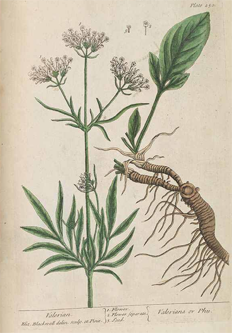Description
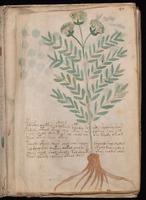 Plant 90r fills most of the page from top to bottom—in fact, it barely fits on the page and one wonders if the parchment at the top has been trimmed.
Plant 90r fills most of the page from top to bottom—in fact, it barely fits on the page and one wonders if the parchment at the top has been trimmed.
The leaves are medium green and painted with a light touch, with some a little lighter green than others and a few with a slightly yellow-green tint. Note how the paint has been applied more carefully than in may of the VMS illustrations. The painting of the roots is less sloppy also.
The leaves are lanceolate, opposite, and odd pinnate. The stem is slender and upright and divides into three at the top, with fluffy flower heads cupped in dark green calyces.
The roots are slightly curved, medium brown, relatively uniform (as roots go)—the kind of roots that are found on many buttercup plants (in other words, no lumps, not distinctly a tap root, and without a distinctive rhizome) except that the top of the root is thick, like a thumb.
There is a sprinkling of small black spots on this page that look like worm holes.
There are two blocks of text near the base that divide across the stem of the plant.
Prior Identifications
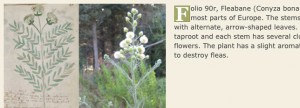 Edith Sherwood has identified this plant as fleabane (Conyza bonariensis), probably based on fleabane’s fluffy seedheads, but the resemblance is only superficial. The VM drawing might be seedheads, but it might also be the flowering phase of the plant and, if so, it doesn’t match as well because C. bonariensis has a fairly tight small flower like a groundsel—it’s shaped a bit like a microphone rather than being broadly open. Even if the VM plant is in the seed stage, it still doesn’t match C. bonariensis very well because fleabane fluffs out into a ball with the calyx hidden within the fluff, like a dandelion.
Edith Sherwood has identified this plant as fleabane (Conyza bonariensis), probably based on fleabane’s fluffy seedheads, but the resemblance is only superficial. The VM drawing might be seedheads, but it might also be the flowering phase of the plant and, if so, it doesn’t match as well because C. bonariensis has a fairly tight small flower like a groundsel—it’s shaped a bit like a microphone rather than being broadly open. Even if the VM plant is in the seed stage, it still doesn’t match C. bonariensis very well because fleabane fluffs out into a ball with the calyx hidden within the fluff, like a dandelion.
C. bonariensis does match Plant 90r in that it has narrow lanceolate leaves, but that’s where the resemblance ends. Unlike C. bonariensis, the leaves of 90r are not branched and they are not opposite. They are not odd pinnate either. Furthermore, the roots are not a good match. C. bonariensis has a fairly beefy tap root that doesn’t branch significantly until a few inches below the ground. Plant 90r has kind of a thick nub that splits into fingers rather than a tap root.
There are a number of plants that more closely resemble the VM plant than C. bonariensis.
Other Possibilities
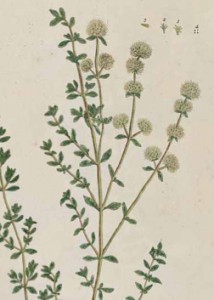 You could argue that Plant 90r is Spanish thyme (Thymus mastichina), a culinary and medicinal plant that grows in Portugal and Iberia. Like Plant 90r, it has fluffy greenish-white heads, branching stems, and opposite leaves. The problem with T. mastichina is that it doesn’t branch as evenly as Plant 90r. The fluffy heads do sometimes split into three (though not as evenly as 90r) but more often they are tiered. The top end of the root isn’t as thick as the VM plant either.
You could argue that Plant 90r is Spanish thyme (Thymus mastichina), a culinary and medicinal plant that grows in Portugal and Iberia. Like Plant 90r, it has fluffy greenish-white heads, branching stems, and opposite leaves. The problem with T. mastichina is that it doesn’t branch as evenly as Plant 90r. The fluffy heads do sometimes split into three (though not as evenly as 90r) but more often they are tiered. The top end of the root isn’t as thick as the VM plant either.
There is a tall spindly plant called Cephalaria uralensis that grows in eastern Europeand Russia. It is related to teasel and has odd-pinnate lanceolate leaves that branch opposite each other, directly from the stem, as they do in the VM plant. It has round, fluffy, creamy-white flowers with long stamens. It might be a good candidate for Plant 90r except that the flower stems are distinctively long (very long) and it has a fairly thick tap root.
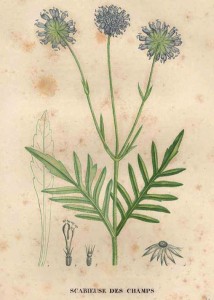 Another cousin of the teasel is Scabiosa canescens, a charming flower with leaves that branch almost exactly like Plant 90r, and a fluffy flower head that turns into an almost spherical seed capsule with protruding sepals. There is usually only one flower at the end of the stem, but sometimes it branches into three lower down on the plant (with long stems like Cephalaria uralensis). A flower that grows in fields in France, Scabiosa arvensis, is similar. Both of these, however, have tap roots.
Another cousin of the teasel is Scabiosa canescens, a charming flower with leaves that branch almost exactly like Plant 90r, and a fluffy flower head that turns into an almost spherical seed capsule with protruding sepals. There is usually only one flower at the end of the stem, but sometimes it branches into three lower down on the plant (with long stems like Cephalaria uralensis). A flower that grows in fields in France, Scabiosa arvensis, is similar. Both of these, however, have tap roots.
Is it possible to find a plant that matches the flowers/seedhead, leaves and the root?
An Old Medicinal Herb
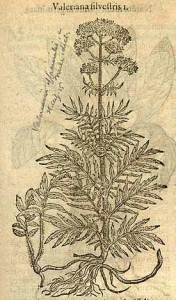
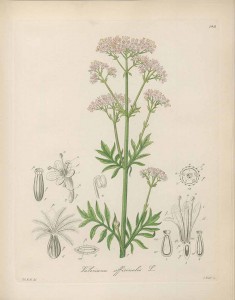 There is a plant that comes very close to Plant 90r in significant ways. It has lanceolate odd-pinnate leaves growing opposite along the stem, stems that split near the top, often into three or more flower heads. Some species have a root with a thumblike knob near the top before it splits into finer roots.
There is a plant that comes very close to Plant 90r in significant ways. It has lanceolate odd-pinnate leaves growing opposite along the stem, stems that split near the top, often into three or more flower heads. Some species have a root with a thumblike knob near the top before it splits into finer roots.
Valeriana is a fairly variable species, but several have odd-pinnate leaves that are a good match for Plant 90r, possibly Valeriana phu, V. sylvatica, or V. dioica. It’s notable that the herbal tradition for depicting this plant in medieval times is to show it splitting into three flower heads even though in nature, it often has more.
 Valerian has a very long history as a medicinal plant and is still a staple in many medicine cabinets. It also has some toxic properties and must be processed and used with care.
Valerian has a very long history as a medicinal plant and is still a staple in many medicine cabinets. It also has some toxic properties and must be processed and used with care.
It would be hard to say whether Plant 90r resembles Valeriana or Scabiosa more closely. The main difference is the root. Scabiosa has a distinct tap root whereas Valerian sometimes has a tap root that is knobby near the stem but then branches more broadly. Depending on how literally one takes the VM drawing, one might lean toward Valeriana. Also, given Valerian’s significant history as a medicinal herb, it would not be surprising to find it in a health-related compendium.
Plant 90r may not be Valeriana (or Scabiosa), but it’s more likely to be either of these than Conyza bonariensis.
J.K. Petersen
© Copyright 2013 J.K. Petersen, All Rights Reserved
————————————————————————————————-
Addendum: I found another picture in my files that illustrates why I’m leaning toward Valerian phu as an ID for Plant 90r. It’s drawn by Elizabeth Blackwell, known for her accuracy in portraying herbs.
Note the fine-textured odd-pinnate leaves that branch to either side (Scabiosa also has this), the three-branched heads of white blossoms, and the three green protrusions cupping each flower head. The root is moderately thick with many root hairs. It matches well with the VMS drawing.

